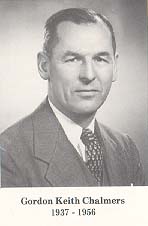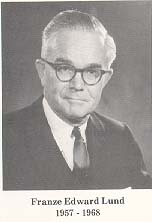|
|
Kenyon College in the 1950s |
|
|
Tucked away in central Ohio, Kenyon College was still an all male college throughout the 1950s. Gordon Keith Chalmers was president of the college from 1937-1956. Having arrived at Kenyon in 1937, upon the resignation of President William Foster Peirce, Chalmers was determined to fortify Kenyon's image. Kenyon College Statistics in early 1950s
|
Peirce Hall 1956 |
|||||||
| Kenyon Life in the 1950s | ||||||||
 |
During his presidency, Chalmers contended with many difficulties. The college suffered during World War II, both in terms of endowment and enrollment. From the period between 1950-1956, the enrollment was typically between 380-400 students. The Old Kenyon fire of 1949, "by far the greatest tragedy ever to strike Kenyon" occurred during his presidency. The fraternities comprised the largest portion of social life at Kenyon. Fraternities once again became a very large part of the campus life, after dwindling during the war and immediate post-war years. By 1950, almost 80% of the student population belonged to fraternities, and Kenyon had acquired somewhat of a reputation as a drinking school. | |||||||
|
|
||||||||
| Chalmers strove to remedy this perception and improve the College's academic reputation by recruiting new faculty members -most notably, poetic-critic, John Crowe Ransom, founder of the Kenyon Review-, holding summer conferences and symposiums, and generally bringing positive attention to the school. Remarkably, Chalmers succeeded in his endeavor, though often at odds with the faculty. By 1956, Kenyon received national recognition in the Chicago Tribune as "The Third Best Men's College in America" only surpassed by Haverford and Amherst. Chalmer's sudden death on May 8, 1956 brought an end to these innovations. Whereas Chalmers had a reputation as being authoritarian and uncompromising, his successor, Franze Edward Lund, was much more reserved. | ||||||||
| Arriving at Kenyon in 1957, Lund became, against his desires, a "brick and mortar" president. The most noteworthy accomplishment under the Lund administration was the addition of new facilities to the physical plant of the College. These new buildings included Phillip Mather Science Hall, Dempsey Hall, Chalmers Memorial Library, Gund Hall, Farr Hall, Bushnell Hall, and Manning Hall. Lund's administration also expanded the College's enrollment from 511 to 800 students, set plans in motion for the co-ordinate women's college, and saw the relocation of Bexley Seminary. Lund resigned as president in 1968. |  |
|||||||
|
America in the 1950s |